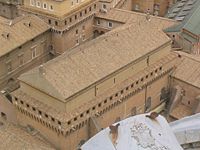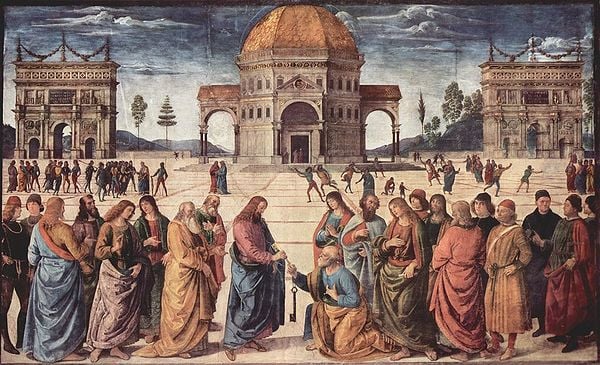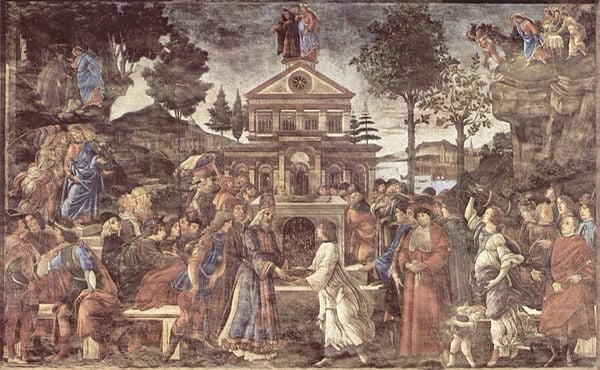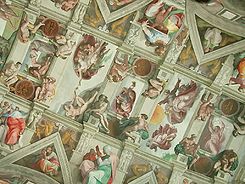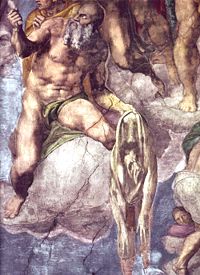Sistine Chapel
The Sistine Chapel (Italian: Cappella Sistina) is a chapel in the Apostolic Palace, the official residence of the Pope, in the Vatican City. Its fame rests on its architecture, which evokes Solomon's Temple of the Old Testament, its decoration, frescoed throughout by the greatest Renaissance artists, including Michelangelo Buonarroti whose ceiling is legendary, and its purpose, as a site of papal religious and functionary activity, notably the conclave, at which a new Pope is selected. Indeed, the Sistine Chapel is more than the sum of its artistic wonders; it is a symbolic statement of papal authority.
Due to the extraordinary talents of Michelangelo (1475-1564), the Sistine Chapel has become one of the most famous art displays in the western world. The famous Sistine ceiling depicts scenes from Genesis in striking detail, and The Last Judgment on the chapel's end wall is equally dramatic. In addition to these famous artworks, the side walls are festooned with frescoes of Moses and Christ and portraits of popes.
In recent decades, the Sistine Chapel has been fastidiously cleaned and restored, beginning with the fifteenth-century, wall frescoes in 1965. The cleaning and restoration of the lunettes, the ceiling, and the Last Judgment, a painstaking process using computer analysis, lasted from 1980 to 1994. The restoration included the removal of several of the "modesty" drapes that had been added over some of the nude figures.
The end result of the restoration has been controversial: Critics say a vital, second layer of paint was removed, and argue that many of the restored figures seem flat compared with the originals, which had more shadow and detail. Others have hailed the project for saving Michelangelo's masterpiece for future generations to appreciate and for revealing the vibrancy of his color palette.
Purpose and history
Most famously, the Sistine Chapel is the place where Papal Conclaves take place for the election of a new pope. More commonly, it is the physical chapel of a corporate body known as the Papal Chapel. At the time of Pope Sixtus IV in the late-fifteenth century, this body comprised about 200 persons, including clerics, officials of the Vatican, and distinguished laity.
The Papal Calendar prescribed 50 occasions during the year that the whole Papal Chapel should meet. Of these, 35 were masses, of which eight were held in Basilicas—generally St. Peters— and were attended by large congregations. These included the Christmas Day and Easter masses, at which the Pope himself was the celebrant. The other 27 masses could be held in a smaller, less-public space, for which the Sistine Chapel was built on the site of its predecessor, the Cappella Maggiore, which had served the same purpose.
The Cappella Maggiore derived its name, the Greater Chapel, from the fact that there was another chapel also in use by the Pope and his retinue for daily worship. At the time of Pope Sixtus IV, this was the Chapel of Pope Nicholas V, which had been decorated by Fra Angelico. The Cappella Maggiore is recorded as existing in 1368. According to a communication from Andreas of Trebizond to Pope Sixtus IV, by the time of its demolition to make way for the present chapel the Cappella Maggiore was in a ruinous state with its walls leaning, . [1]
The present chapel, on the site of the Cappella Maggiore, was designed by Baccio Pontelli for Pope Sixtus IV, for whom it is named, and built under the supervision of Giovannino de Dolci between 1473 and 1484. The proportions of the present chapel appear to follow those of the original closely. After its completion, the chapel was decorated with frescoes by a number of the most famous artists of the late-fifteenth century, including Botticelli, Ghirlandaio and Perugino. [1]
The first mass in the Sistine Chapel was celebrated on August 9, 1483, the Feast of the Assumption, at which ceremony the chapel was consecrated and dedicated to the Virgin Mary.
The Sistine Chapel has maintained its function to the present day, and continues to host the important services of the Papal Calendar, unless the Pope is travelling. There is a permanent choir for whom much original music has been written, the most famous piece being Allegri's Miserere, a setting of the psalm for Maundy Thursday.
Papal Conclave
One of the most significant functions of the Sistine Chapel is as a venue for the election of each successive pope in a conclave of the College of Cardinals. The 1492 papal conclave was the first to use the Sistine Chapel for this purpose.
On the occasion of a conclave, a chimney is installed in the roof of the chapel, from which smoke arises as a signal. If white smoke appears, created by burning the ballots of the election and some chemical additives, a new Pope has been elected. If the cardinals send up black smoke, created by burning the ballots along with wet straw or other chemical additives, it means that no successful election has yet occurred. This method has become somewhat unreliable at times, with mixed readings of the chimney smoke as recently as the conclaves electing John Paul I and John XXIII.
During present-day meetings of cardinals, the chapel is carefully searched for bugs, recorders, and cameras. The floor is raised to accommodate the necessary equipment. The Cardinals themselves are also not permitted to use cellular phones, or even newspapers, while sequestered to ensure total liberty to vote without any undue outside influences. In previous times, the windows were even painted over.
Canopies for each cardinal-elector were once used during conclaves — a sign of equal dignity. After the new Pope accepts his election, he would give his new name; at this time, the other Cardinals would tug on a rope attached to their seats to lower their canopies. Until reforms instituted by Saint Pius X, the canopies were of different colors to designate which Cardinals had been appointed by which Pope. Paul VI abolished the canopies all together, since under his papacy, the population of the College of Cardinals had increased so much to the point that they would need to be seated in rows of two against the walls, making the canopies obstruct the view of the cardinals in the back row.
Architecture
Exterior
The Sistine Chapel is a high, rectangular, brick building; its exterior unadorned by architectural or decorative details, as is common in many Medieval and Renaissance churches in Italy. It has no exterior facade or exterior processional doorways, as the ingress has always been from internal rooms within the Papal Palace. The internal spaces are divided into three stories of which the lowest is a robustly vaulted basement with several utilitarian windows and a doorway giving onto the exterior court.
Above is the main space, the Chapel, the internal measurements of which are 134 feet long by 44 feet wide, (the dimensions of the Temple of Solomon, as given in the Old Testament). The vaulted ceiling rises to 68 feet. The building had six tall, arched windows down each side and two at either end. Several of these have been blocked.
Above the vault rises a third story with wardrooms for guards. At this level was constructed an open, projecting gangway which encircled the building supported on an arcade springing from the walls. The gangway has been roofed since there was a continual source of water penetration to the vault of the Chapel. The building is roofed with pantile tiles.
Subsidence and cracking of masonry, such as must also have affected the Cappella Maggiore, has necessitated the building of very large buttresses to brace the exterior walls. The accretion of other buildings has further altered the exterior appearance of the Chapel.
Interior
As with most buildings measured internally, absolute measurement is hard to ascertain. However, the general proportions of the chapel are clear to within a few centimeters. The length is the module of measurement and has been divided by three to get the width and by two to get the height. There is a ratio of 6:2:3 between the length, width, and height. Maintaining the ratio, there were six windows down each side and two at either end. The screen which divides the chapel was originally placed half way from the altar wall, but this has changed. Clearly defined proportions were a feature of Renaissance architecture and reflected the growing interest in the Classical heritage of Rome.
The ceiling of the chapel is a flattened barrel vault springing from a course that encircles the walls at the level of the springing of the window arches. This barrel vault is cut transversely by smaller vaults over each window, which divide the barrel vault at its lowest level into a series of large pendentives rising from shallow pilasters between each window. The barrel vault was originally painted brilliant blue and dotted with gold stars, to the design of Pier Matteo d'Amelia. [1] The pavement is in opus alexandrinum, a decorative style using marble and colored stone in a pattern that reflects the earlier proportion in the division of the interior, and also marks the processional way form the main door, used by the Pope on important occasions such as Palm Sunday.
The screen or transenna in marble by Mino da Fiesole, Andrea Bregno, and Giovanni Dalmata divides the chapel into two parts. Originally these made equal space for the members of the Papal Chapel within the sanctuary near the altar and the pilgrims and townsfolk without. However, with growth in the number of those attending the Pope, the screen was moved giving a reduced are for the faithful laity.
The transenna is surmounted by a row of ornate candlesticks, once gilt, and has a wooden door, where once there was an ornate door of gilded, wrought iron. The sculptors of the transenna also provided the cantoria or projecting choir gallery.
Raphael's tapestries
During occasional ceremonies of particular importance, side walls are covered with a series of tapestries originally commissioned for the chapel by Raphael, but looted by the French armies and scattered around Europe. The tapestries depict events from the Life of St Peter and the Life of St Paul as described in the Gospels and the Acts of the Apostles. In the late-twentieth century the set was reassembled and displayed again in the Sistine Chapel in 1983.
Decoration
The pictorial decoration of the Sistine Chapel comprises frescoes and a set of tapestries. They are the work of different artists and are part of a number of different commissions, some of which were in conflict with each other.
The walls are divided into three main tiers. The lower is decorated with frescoed, wall hangings in silver and gold. The central tier of the walls has two cycles of paintings, which complement each other, The Life of Moses and The Life of Christ. They were commissioned in 1480 by Pope Sixtus IV and executed by Ghirlandaio, Botticelli, Perugino and Cosimo Roselli and their workshops.
The upper tier is divided into two zones. At the lower level of the windows is a Gallery of Popes painted at the same time as the Lives. Around the arched tops of the windows are areas known as the lunettes which contain the Ancestors of Christ, painted by Michelangelo as part of the scheme for the ceiling.
The ceiling, commissioned by Pope Julius II and famously painted by Michelangelo from 1508 to 1511, has a series of nine paintings showing God's Creation of the World, God's relationship with Mankind and Mankind's fall from God's Grace. On the large pendentives that support the vault are painted 12 Biblical and Classical men and women who prophesied that God would send Jesus Christ for the salvation of mankind.
Subsequently, Raphael was commissioned by Pope Leo X to design a series of tapestries to hang around the lower tier of the walls. These depict the lives of the two leaders among the Apostles who established the Christian church in Rome, Saints Peter and Paul.
Although Michelangelo's complex design for the ceiling was not quite what his patron, Pope Julius II, had in mind when he commissioned Michelangelo to paint the Twelve Apostles, the scheme displayed a consistent iconographical pattern. However, this was disrupted by the a further commission to Michelangelo to decorate the wall above the altar with The Last Judgement, 1537-1541. The painting of this scene necessitated the obliteration of two episodes from the Lives, several of the Popes and two sets of Ancestors. Two of the windows were blocked and two of Raphael's tapestries became redundant.
Frescos
The wall paintings were executed by premier painters of the fifteenth century: Perugino, Botticelli, Ghirlandaio, Rossellini, Signorelli and their respective workshops, which included Pinturicchio, Piero di Cosimo and Bartolomeo della Gatta. The subjects were historical religious themes, selected and divided according to the medieval concept of the partition of the world history into three epochs: before the Ten Commandments were given to Moses, between Moses and Christ's birth, and the Christian era thereafter. They underline the continuity between the Old Covenant and the New Covenant, or the transition from the Mosaic law to the Christian religion.
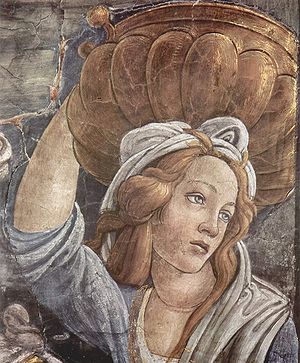
|
| Scenes of the Life of Moses (detail) |
| Sandro Botticelli, 1481-1482 |
| Fresco |
| , 137.2 × 219.7 in |
| Sistine Chapel, The Vatican |
The walls were painted over an astonishingly short period of time, barely 11 months, from July 1481 to May 1482. The painters were each required first to execute a sample fresco; these were to be officially examined and evaluated in January 1482. However, it was so evident at such an early stage that the frescoes would be satisfactory that by October 1481, the artists were given the commission to execute the remaining 10 stories.
The pictorial program for the chapel was comprised of a cycle each from the Old and New Testament of scenes from the lives of Moses and Christ. The narratives began at the altar wall -the frescoes painted there yielding to Michelangelo's Last Judgment a mere 30 years later - continued along the long walls of the chapel, and ended at the entrance wall. A gallery of papal portraits was painted above these depictions, and the latter were completed underneath by representations of painted curtains. The individual scenes from the two cycles contain typological references to one another. The Old and New Testament are understood as constituting a whole, with Moses appearing as the prefiguration of Christ.
The typological positioning of the Moses and Christ cycles has a political dimension going beyond a mere illustrating of the correspondences between Old and New Testament. Sixtus IV was employing a precisely conceived program to illustrate through the entire cycle the legitimacy of papal authority, running from Moses, via Christ, to Peter, whose ultimate authority, conferred by Christ, ultimately to the present Popet. The portraits of the latter above the narrative depictions served emphatically to illustrate the ancestral lineage of their God-given authority.
The two most important scenes from the fresco cycle, Perugino's Christ Giving the Keys to St. Peter and Botticelli's The Punishment of Korah; both contain in the background the triumphal arch of Constantine, the first Christian emperor, who gave the Pope temporal power over the Roman western world. The triumphal arch alludes to the imperial grant of papal power of the Pope. Sixtus IV was thereby not only illustrating his position in a line of succession starting in the Old Testament and continuing through the New Testament up to contemporary times, but was simultaneously restating the view of the papacy as the legitimate successor to the Roman Empire.
Christ Giving the Key to St. Peter
This fresco is located in the fifth compartment in the northern wall.
Among Perugino's frescoes in the Chapel, the Christ Giving the Keys to St. Peter is stylistically the most instructive. This scene is a reference to the bible passage in which the "keys" to heaven are given to not only St. Peter but to the entire fellowship of believers. These keys represent the power to forgive and to share the word of God, thereby giving them the power to allow others into heaven. The main figures are organized in a frieze in two tightly compressed rows close to the surface of the picture and well below the horizon. The principal group, showing Christ handing the silver and gold keys to the kneeling St. Peter, is surrounded by the other Apostles, including Judas (fifth figure to the left of Christ), all with halos, together with portraits of contemporaries, including one said to be a self-portrait (fifth from the right edge). The flat, open square is divided by colored stones into large foreshortened rectangles, although they are not used in defining the spatial organization. Nor is the relationship between the figures and the felicitous invention of the porticoed Temple of Solomon that dominates the picture effectively resolved. The triumphal arches at the extremities appear as superfluous antiquarian references, suitable for a Roman audience. Scattered in the middle distance are two secondary scenes from the life of Christ, including the Tribute Money on the left and the Stoning of Christ on the right.
The style of the figures is inspired to Verrocchio. The active drapery, with its massive complexity, and the figures, particularly several apostles, including St. John the Evangelist, with beautiful features, long flowing hair, elegant demeanor, and refinement recall St Thomas from Verrocchio's bronze group on Orsanmichele. The poses of the actors fall into a small number of basic attitudes that are consistently repeated, usually in reverse from one side to the other, signifying the use of the same cartoon. They are graceful and elegant figures who tend to stand firmly on the earth. Their heads are smallish in proportion to the rest of their bodies, and their features are delicately distilled with considerable attention to minor detail.
The octagonal temple with its ample porches that dominates the central axis must have had behind it a project created by an architect, but Perugino's treatment is like the rendering of a wooden model, painted with exactitude. The building with its arches serves as a backdrop in front of which the action unfolds. Perugino has made a significant contribution in rendering the landscape. The sense of an infinite world that stretches across the horizon is stronger than in almost any other work of his contemporaries, and the feathery trees against the cloud-filled sky with the bluish-gray hills in the distance represent a solution that later painters would find instructive, especially Raphael.
Scenes of the Life of Moses
Botticelli painted three scenes within the short period of 11 months: Scenes from the Life of Moses, The Temptation of Christ, and The Punishment of Korah. He also painted, with much help from his workshop, in the niches above the biblical scenes, some portraits of popes which have been considerably painted over. In all these works his painting appears relatively weak.
The Scenes of the Life of Moses fresco is opposite The Temptation of Christ, also painted by Botticelli. The two pictures are typologically related in that both deal with the theme of temptation. Botticelli integrated seven episodes from the life of the young Moses into the landscape with considerable skill, by opening up the surface of the picture with four diagonal rows of figures.
As the Moses cycle starts on the wall behind the altar, the scenes should, unlike the pictures of the temptations of Christ, be read from right to left: (1) Moses in a shining yellow garment, angrily strikes an Egyptian overseer and then (2) flees to the Midianites. There (3) he disperses a group of shepherds who were preventing the daughters of Jethro from (4) drawing water at the well. After (5,6) the divine revelation in the burning bush at the top left, Moses obeys God's commandment and (7) leads the people of Israel in a triumphal procession from slavery in Egypt.
The Punishment of Korah
The message of this painting provides the key to an understanding of the Sistine Chapel as a whole before Michelangelo's work. The fresco reproduces three episodes, each of which depicts a rebellion by the Hebrews against God's appointed leaders, Moses and Aaron, along with the ensuing divine punishment of the agitators. On the right-hand side, the revolt of the Jews against Moses is related, the latter portrayed as an old man with a long white beard, clothed in a yellow robe and an olive-green cloak. Irritated by the various trials through which their emigration from Egypt was putting them, the Jews demanded that Moses be dismissed. They wanted a new leader, one who would take them back to Egypt, and they threatened to stone Moses; however, Joshua placed himself protectively between them and their would-be victim, as depicted in Botticelli's painting.
The center of the fresco shows the rebellion, under the leadership of Korah, of the sons of Aaron and some Levites, who, setting themselves up in defiance of Aaron's authority as high priest, also offered up incense. In the background, we see Aaron in a blue robe, swinging his incense censer with an upright posture and filled with solemn dignity, while his rivals stagger and fall to the ground with their censers at God's behest. Their punishment ensues on the left-hand side of the picture, as the rebels are swallowed up by the earth, which is breaking open under them. The two innocent sons of Korah, the ringleader of the rebels, appear floating on a cloud, exempted from the divine punishment.
The principal message of these scenes is made manifest by the inscription in the central field of the triumphal arch: "Let no man take the honour to himself except he that is called by God, as Aaron was." The fresco thus holds a warning that God's punishment will fall upon those who oppose God's appointed leaders. This warning also contained a contemporary, political reference through the portrayal of Aaron in the fresco, depicted wearing the triple-ringed tiara of the Pope and thus characterized as the papal predecessor. It was a warning to those questioning the ultimate authority of the Pope over the Church. The papal claims to leadership were God-given, their origin lay in Christ giving Peter the keys to the kingdom of heaven and thereby granting him primacy over the young Church. Perugino painted this crucial element of the doctrine of papal supremacy immediately opposite Botticelli's fresco.
The Temptation of Christ
The fresco which Botticelli began in July, 1481, is the third scene within the Christ cycle and depicts the Temptation of Christ. Christ's threefold temptation by the Devil, as described in the Gospel according to Matthew, can be seen in the background of the picture, with the devil disguised as a hermit. At top left, up on the mountain, he is challenging Christ to turn stones into bread; in the center, we see the two standing on a temple, with the Devil attempting to persuade Christ to cast himself down; on the right-hand side, finally, he is showing the Son of God the splendor of the world's riches, over which he is offering to make Him master. However, Christ drives away the Devil, who ultimately reveals his true devilish form.
On the right in the background, three angels have prepared a table for the celebration of the Eucharist, a scene which only becomes comprehensible when seen in conjunction with the event in the foreground of the fresco. The unity of these two events from the point of view of content is clarified by the reappearance of Christ with three angels in the middle ground on the left of the picture, where He is apparently explaining the incident occurring in the foreground to the heavenly messengers. We are concerned here with the celebration of a Jewish sacrifice, conducted daily before the Temple in accordance with ancient custom. The high priest is receiving the blood-filled sacrificial bowl, while several people are bringing animals and wood as offerings.
At first sight, the inclusion of this Jewish sacrificial scene in the Christ cycle would appear extremely puzzling; however, its explanation may be found in the typological interpretation. The Jewish sacrifice portrayed here refers to the crucifixion of Christ, who through His death offered of His flesh and blood for the redemption of mankind. Christ's sacrifice is reconstructed in the celebration of the Eucharist, alluded to here by the gift table prepared by the angels.
Michelangelo's painting
Michelangelo Buonarroti was commissioned by Pope Julius II in 1508 to repaint the ceiling, originally representing golden stars on a blue sky; the work was completed between 1508 and 1 November 1512. He painted the Last Judgment over the altar, between 1535 and 1541, being commissioned by Pope Paul III Farnese. Michelangelo felt that he was a more developed sculptor than a painter, but he accepted the offer.
- Sistine.left.600pix.jpg
Left section of the ceiling, after restoration
- Sistine.leftcentre.600pix.jpg
Left centre section of the ceiling, after restoration
- Sistine.rightcentre.600pix.jpg
Right center section of the ceiling, after restoration
- Sistine.right.600pix.jpg
Right section of the ceiling, after restoration
Ceiling
In 1508 Michelangelo was commissioned by Pope Julius II to paint the vault, or ceiling of the chapel. It took him until 1512 to complete. To be able to reach the ceiling, Michelangelo needed a support; the first idea was by Bramante, who wanted to build for him a special scaffold, suspended in the air with ropes. But Michelangelo suspected that this would leave holes in the ceiling once the work was ended, so he built a scaffold of his own, a flat wooden platform on brackets built out from holes in the wall, high up near the top of the windows. He stood on this scaffolding while he painted.
The first layer of plaster began to grow mold because it was too wet. Michelangelo had to remove it and start again, so he tried a new mixture of plaster, called intonaco, which was resistant to mold. It was created by one of Michelangelo's assistants, Jacopo l'Indaco, and is still in use today.
Michelangelo used bright colors, easily visible from the floor. On the lowest part of the ceiling he painted the ancestors of Christ. Above this he alternated male and female prophets, with Jonah over the altar. On the highest section Michelangelo painted nine stories from the Book of Genesis.
Michelangelo was originally commissioned to paint only 12 figures, the Apostles. He turned down the commission because he saw himself as a sculptor, not a painter. The Pope offered to allow Michelangelo to paint biblical scenes of his own choice as a compromise. When the work was finished there were more than 300. His figures showed the creation, Adam and Eve in the Garden of Eden and the Great Flood.
Last Judgment
The Last Judgment was painted by Michelangelo from 1535-1541, after the Sack of Rome of 1527 by Protestant forces from the Holy Roman Empire, which effectively ended the Roman Renaissance, and just before the Council of Trent, a time of great uncertainty as to the future of the church. The work is massive and spans the entire wall behind the altar of the Sistine Chapel. The Last Judgment is a depiction of the second coming of Christ and the apocalypse. The souls of humanity rise and descend to their fates as judged by Christ and his saintly entourage. The wall on which The Last Judgment is painted cants out slightly over the viewer as it rises, and is meant to be somewhat fearful and to instill piety and respect for God's power. In contrast to the other frescoes in the Chapel, the figures are heavily muscled and appear somewhat tortured – even the Virgin Mary at the center cowers beneath him.
The Last Judgment was an object of a heavy dispute between Cardinal Carafa and Michelangelo: the artist was accused of immorality and intolerable obscenity, having depicted naked figures, with genitals in evidence, so a censorship campaign (known as the "Fig-Leaf Campaign") was organized by Carafa and Monsignor Sernini (Mantua's ambassador) to remove the frescoes. When the Pope's own Master of Ceremonies, Biagio da Cesena, said "it was mostly disgraceful that in so sacred a place there should have been depicted all those nude figures, exposing themselves so shamefully, and that it was no work for a papal chapel but rather for the public baths and taverns," Michelangelo worked da Cesena's semblance into the scene as Minos, judge of the underworld. It is said that when he complained to the Pope, the pontiff responded that his jurisdiction did not extend to hell, so the portrait would have to remain.
The genitalia in the fresco were later covered by the artist Daniele da Volterra, whom history remembers by the derogatory nickname "Il Braghettone" ("the breeches-painter").
Restoration and controversy
The chapel has been recently restored (1981 through 1994). This restoration was initially surrounded by a heated controversy in the art world, some claiming it a success and a breakthrough revelation, while a few claiming it ruined the masterpiece. Some conservationists complained about the loss of a brown patina that had developed over centuries, composed of candle smoke, soot, and repeated applications of poor quality varnish. Despite evidence to the contrary, they claim that this layer of murky material was actually applied by Michelangelo himself in order to "harmonise" what they called 'ice-cream colours.' (Because no substantial evidence has been found proving that these were Michelangelo's original intentions, the arguments are often disregarded.) The bright colours reveal Michelangelo to have been a masterful colourist, and close-ups of the frescos show complex brushwork that would not be matched, nor even attempted until the Impressionist movement of the 19th century. Others comment that bright colours were necessary for the frescos to stand out in the gloom of the chapel, with its high, narrow windows. Now that the electric lighting has been removed and the frescos illuminated solely by the light from the windows, the original colours and effect have been restored.
Notes
- ↑ 1.0 1.1 1.2 John Shearman, "The Chapel of Sixtus IV," in The Sistine Chapel, editor Alberto Giacometti, Harmony Books, 1986, ISBN 0-517-56274-X
ReferencesISBN links support NWE through referral fees
- Giacometti, Alberto (Ed.) The Sistine Chapel, Harmony Books, 1986, ISBN 0-517-56274-X
- Stone, Irving. The Agony and the Ecstasy, Signet, 1961.ISBN 978-0451171351
- King, Ross. Michelangelo and the Pope's Ceiling, Pimlico, 2006. ISBN 978-1844139322
- Seymour, Charles (Ed.) Michelangelo: The Sistine Chapel Ceiling, W.W. Norton & Company, 1995. ISBN 978-0393314052
- Hall, Marcia B. Michelangelo: The Frescoes of the Sistine Chapel, Harry N. Abrams, 2002. ISBN 978-0810935303
- Mancinelli, Fabrizio. The Sistine Chapel, Treasures Inc., 1996. ISBN 978-8886921015
- Pietrangeli, Carlo, & Okamura, Takashi (photographer). The Sistine Chapel: A Glorious Restoration, Abradale Press, 1999. ISBN 978-0910981768
External links
- Vatican Museums Online: Sistine Chapel — A virtual detailed tour of the frescoes and panels
- Master Plan & Pictures: Cappella Sistina
- Web Gallery of Art: Visit to the Sistine Chapel in Vatican
Credits
New World Encyclopedia writers and editors rewrote and completed the Wikipedia article in accordance with New World Encyclopedia standards. This article abides by terms of the Creative Commons CC-by-sa 3.0 License (CC-by-sa), which may be used and disseminated with proper attribution. Credit is due under the terms of this license that can reference both the New World Encyclopedia contributors and the selfless volunteer contributors of the Wikimedia Foundation. To cite this article click here for a list of acceptable citing formats.The history of earlier contributions by wikipedians is accessible to researchers here:
The history of this article since it was imported to New World Encyclopedia:
Note: Some restrictions may apply to use of individual images which are separately licensed.
